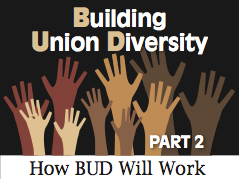 Unique pre-apprenticeship program to be tested by five unions
Unique pre-apprenticeship program to be tested by five unions
Part 2: How BUD will work
By ED FINKELSTEIN
Publisher
Just as the St. Louis construction industry in 1972 created PRIDE, the nation’s premier labor-management cooperative effort, in 2014 the St. Louis building trades unions are creating a second innovation that could become a model for America – BUD, the acronym for Building Union Diversity.
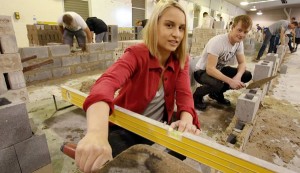 BUD is an innovative experiment that will help disadvantaged groups become a real part of the construction scene ultimately as apprentices in jointly trusted labor-management apprenticeship training schools and then as full-fledged journeymen.
BUD is an innovative experiment that will help disadvantaged groups become a real part of the construction scene ultimately as apprentices in jointly trusted labor-management apprenticeship training schools and then as full-fledged journeymen.
BUD’s is a pre-apprenticeship training program built on reality, not a pipe dream. Its goal is to give minorities and women the opportunity to learn a craft that will last a lifetime.
To date, five unions have committed to participate. They are Bricklayers Local 1, Operating Engineers Local 513, Iron Workers Local 396, Plumbers & Pipefitters Local 562 and the Carpenters’ District Council. Several more trades are actively considering participation.
POOR FINISH RATE
“Under many of today’s so-called training programs for minorities offered by a number of organizations, less than ten percent that start the training complete it, and even fewer have been able to find jobs,” said Jeff Aboussie, executive secretary-treasurer of the St. Louis Building & Construction Trades Council, the original architect of BUD along with John Gaal, EdD, St. Louis Carpenters’ District Council’s director of Training & Workforce Development and Tim Keane, PhD, St. Louis University’s professor of management.
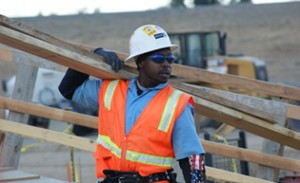 Part of that is because of the down economy. Not much construction, therefore not much hiring of skilled workers, much less those with lesser or no real skills.
Part of that is because of the down economy. Not much construction, therefore not much hiring of skilled workers, much less those with lesser or no real skills.
The other part of that is too often minorities and women are “hired” on a job to fill a project-specific quota but really don’t have the training to do skilled work. As a result, they are given simple repetitive tasks to keep them busy. Once the project is completed, they can’t find other work.
Or, a small group of skilled minorities are moved from job-to-job to give the appearance of inclusion.
TIME FOR CHANGE
Aboussie, Gaal and Keane, the driving forces behind BUD. Each is truly passionate about seeing BUD be successful so that minorities and young women can become a meaningful part of the construction industry.
In today’s construction environment, “diversity” has become a critical issue.
Governments and companies are insistent that more minorities are on their construction projects so that they too have the opportunity to earn a solid middle class living that union construction work provides.
And it’s not that the unions haven’t tried. Going to job fairs, into high schools and attending career days to find qualified young minorities and women has not worked a well as hoped.
And so BUD was born.
THE BUD PROCESS
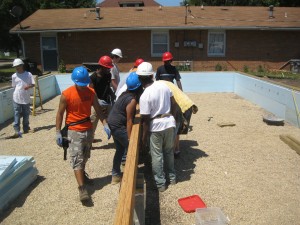 Working with community groups, there will be an active outreach to find young people who say they are interested in construction work. But are they really, or does the allure of a “good paying job” stoke that interest?
Working with community groups, there will be an active outreach to find young people who say they are interested in construction work. But are they really, or does the allure of a “good paying job” stoke that interest?
BUD will help them determine if construction is for them through a multiple week, hands-on pre-apprenticeship program that will give applicants:
• FIRST, a clear understanding of what it takes to succeed as an apprentice in construction. Too often in the minds of young people the “image” of the job and the “reality” are two different issues. BUD will stress the reality so no one is blindsided as to what’s required to be successful.
• SECOND, a real hands on feel for a variety of trades to determine what they really want to be – and are capable of achieving.
HOW BUD WILL WORK
Here’s how it will work:
STEP 1 – Applicants will be recommended for the program by any number of groups including SLATE (St. Louis Agency on Training & Employment), the NAACP, and both Faith-based and Community-based organizations.
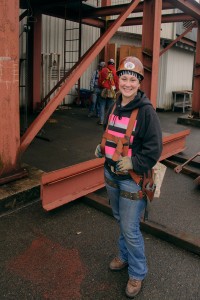 STEP 2 – As a single group, applicants will undergo an intensive first week general orientation to help them understand what’s needed to be a successful building tradesperson. They must pass a drug test and a basic ACT (WorkKeys) math skills assessment. They will be told that to succeed in this career, they are ultimately going to need a car with insurance to get to work. For those who meet these criteria, it’s on to…
STEP 2 – As a single group, applicants will undergo an intensive first week general orientation to help them understand what’s needed to be a successful building tradesperson. They must pass a drug test and a basic ACT (WorkKeys) math skills assessment. They will be told that to succeed in this career, they are ultimately going to need a car with insurance to get to work. For those who meet these criteria, it’s on to…
STEP 3 – Spending the next several weeks, a week at a time, rotating into each of the participating trades’ apprenticeship training programs to get a hands-on feel what’s required of that craft.
The week with each of the five participating unions will include classroom as well as job-site and shop experiences. The goal: expose them to what it really takes to work in a specific trade to help them discover for themselves if that’s a trade they want to work in for the rest of their lives.
After successfully completing the general orientation week, participants will receive $100 a week from a grant SLATE obtained from the Missouri Department of Economic Development.
STEP 4 – Sorting the completers into two groups: an A list of those who came through with flying colors and a B list, those who finished but still may need some assistance fulfilling program requirements. These names will then be entered into a master database so that when apprenticeship openings become available, these young people can be called up.
Discussions are underway to provide BUD graduates with advanced credit for completing the pre-apprenticeship program, credit that will move them further up the ladder when it comes time to bring in qualified apprentices into a trade’s jointly trusted apprenticeship programs.
STEP 5 – Creation of a master availability list of minorities and women of out-of-work journeymen, current apprentices and BUD pre-apprentice graduates. A basic list will be compiled by SLATE with each participating union maintaining its own list. When a contractor calls for a specific skill, SLATE will contact the appropriate union for names of qualified journeymen, apprentices or pre-apprentices to be given to contractors.
As more work is generated with an improving economy and the lists of trained journeymen and in-training apprentices depletes, there will be a growing demand for new apprentices to come into the industry, and their availability will be assured.
(Part 3 – Bringing the unions, community on board)
[box style=”4″]
Need for new construction workers is strong, growing
BUD is coming at the absolutely right time, according to predictions throughout the construction industry.
• The Construction Users Council predicts the industry will experience a shortage of two million construction workers by 2017.
• The Bureau of Labor Statistics predicts that the next decade will see a dramatic uptrend in construction industry employment. Jobs for construction workers are expected to show double digit increases between 2010 and 2020, with some segments of the industry expected to increase by as much as 24 percent during that timeframe.
According to The Aspen Institute Workforce Strategies Initiative:
• The recent economic recession substantially reduced the construction labor force, as employment levels in the industry precipitously declined from a peak of 7.7 million in 2007 to 5.6 million in 2012 (the latest figures available).
• Long-term demographic trends suggest that the construction workforce has aged substantially, with baby boomers making up more than 40 percent of the workforce.
• Layoffs and retirements have further weakened the talent pool in the construction sector, potentially undermining the industry’s capacity to respond to future demand for building and modernizing the nation’s infrastructure, housing stock, and commercial and industrial properties.
All of this makes it essential for the industry to educate young people early on about the opportunities available in construction to meet tomorrow’s building needs.
BUD is happening not a moment too soon. [/box]

